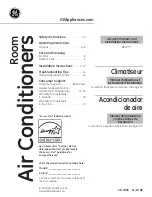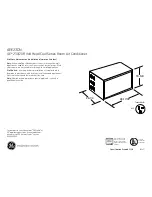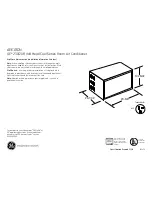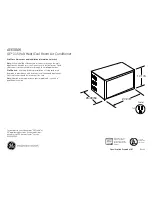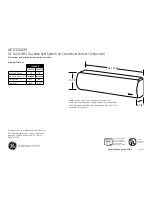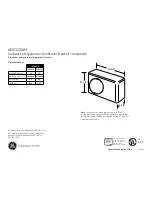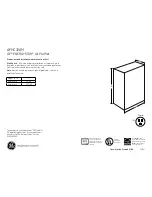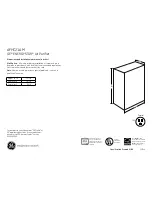
7
4.2. Connecting pipes (Fig. 4-2)
Fig. 4-1 is a sample of piping system.
• Conduct suf
fi
cient anti-condensation and insulation work to prevent water
dripping from the refrigerant piping. (liquid pipe/gas pipe)
• Increase insulation depending on the environment where the refrigerant piping is
installed, or condensation may occur on the surface of the insulation material.
(Insulation material Heat-resistant temperature: 120 °C, Thickness: 15 mm or
more)
* When the refrigerant piping is used in locations subject to high temperature
and humidity such as in the attic, further addition of insulation may be
required.
• To insulate the refrigerant piping, apply heat-resistant polyethylene foam between
the indoor unit and insulation material as well as to the net between the insulation
material
fi
lling all gaps.
(Condensation forming on the piping may result in condensation in the room or
burns when contacting the piping.)
• The indoor parts of the drain pipe should be wrapped with polyethylene foam insula-
tion materials (speci
fi
c gravity of 0.03, thickness of 9 mm or more).
• Apply thin layer of refrigerant oil to pipe and joint seating surface before tightening
fl
are nut.
A
• Use two wrenches to tighten piping connections.
B
• Use leak detector or soapy water to check for gas leaks after connections are
completed.
• Apply refrigerating machine oil over the entire
fl
are seat surface.
C
• Use the
fl
are nuts for the following pipe size.
D
Indoor unit
Outdoor unit
15-50
63-140
100-140
Gas side
Pipe size (mm)
ø12.7
ø15.88
ø15.88
Liquid side Pipe size (mm)
ø6.35
ø9.52
ø9.52
• When bending the pipes, be careful not to break them. Bend radius of 100 mm to
150 mm is suf
fi
cient.
• Make sure the pipes do not contact the compressor. Abnormal noise or vibration
may result.
1
Pipes must be connected starting from the indoor unit.
Flare nuts must be tightened with a torque wrench.
2
Flare the liquid pipes and gas pipes and apply a thin layer of refrigeration oil (Ap-
plied on site).
• When usual pipe sealing is used, refer to Table 3 for
fl
aring of R410A refrigerant
pipes.
The size adjustment gauge can be used to con
fi
rm A measurements.
A
(mm)
A
Liquid pipe
B
Gas pipe
PUMY-P125,140
ø9.52
ø15.88
B, C, D
(mm)
C
Total capacity of indoor units
A
Liquid pipe
B
Gas pipe
ø9.52
ø15.88
a, b, c, d, e, f
(mm)
D
Model number
A
Liquid pipe
B
Gas pipe
15, 20, 25, 32, 40, 50
ø6.35
ø12.7
63, 80, 100, 125, 140
ø9.52
ø15.88
E
Branch kit model
CMY-Y62-G-E
F
4-Branching header
G
8-Branching header
CMY-Y64-G-E
CMY-Y68-G-E
A
Flare cutting dimensions
B
Flare nut tightening torque
A
Die
B
Copper pipe
Fig. 4-2
A
Fig. 4-3
A
(Fig.
4-2)
B
(Fig.
4-2)
Table 3 (Fig. 4-3)
4. Installing the refrigerant piping
A
H
B
C
L
ℓ
D
e
a
h
b
c
d
A
a
b
c
d
e
f
H
h
L
ℓ
A
: Outdoor Unit
B
: First Branch
C
: Indoor unit
D
: Cap
A+B+C+D+a+b+c+d+e 120 m
L = A+B+C+D+e 80 m
ℓ
= B+C+D+e 30 m
H 50 m (Outdoor lower H 20 m)
h 12 m
A+a+b+c+d+e+f 120 m
L = A+f 80 m,
ℓ
= f 30 m
H 50 m (Outdoor lower H 20 m)
h 12 m
Fig. 4-1
90°± 0.5°
øA
45°± 2°
R0.4 - R0.8
Copper pipe O.D. (mm)
A (mm)
Flare tool for R410A
Flare tool for R22·R407C
Clutch type
ø6.35 (1/4
″
)
0 - 0.5
1.0 - 1.5
ø9.52 (3/8
″
)
0 - 0.5
1.0 - 1.5
ø12.7 (1/2
″
)
0 - 0.5
1.0 - 1.5
ø15.88 (5/8
″
)
0 - 0.5
1.0 - 1.5
ø19.05 (3/4
″
)
0 - 0.5
1.0 - 1.5
Copper pipe O.D.
(mm)
Flare dimensions
øA dimensions (mm)
ø6.35
8.7 - 9.1
ø9.52
12.8 - 13.2
ø12.7
16.2 - 16.6
ø15.88
19.3 - 19.7
Copper pipe O.D.
(mm)
Flare unt O.D.
(mm)
Tightening torque
(N·m)
ø6.35
17
14 - 18
ø6.35
22
34 - 42
ø9.52
22
34 - 42
ø12.7
26
49 - 61
ø12.7
29
68 - 82
ø15.88
29
68 - 82
ø15.88
36
100 - 120




















